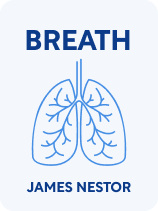

This article is an excerpt from the Shortform book guide to "Breath" by James Nestor. Shortform has the world's best summaries and analyses of books you should be reading.
Like this article? Sign up for a free trial here.
Why do most people breathe incorrectly? How does wrong breathing affect your brain and body?
According to James Nestor, the author of Breath, the breathing problems experienced by millions of people today can be traced to how our sinuses and throats evolved over the ages. As a result, we developed a tendency to breathe suboptimally.
In this article, you’ll learn why our bodies are poorly adapted to breathing and the two main ways that most of us breathe wrong.
Breathing Poorly
Nestor asserts that through no fault of our own, the advances we’ve made biologically and technologically over the past two million years have caused the human race to develop the most poorly designed breathing organs in the animal kingdom.
(Shortform note: The Global Burden of Disease Study in 2017 showed that 550 million people suffer from some form of chronic breathing problem. In the US in 2016, breathing problems resulted in 85 million medical visits. One contributing factor that Nestor doesn’t mention is damage caused by smoking, which accounts for 90% of lung cancer deaths and 80% of deaths from chronic obstructive pulmonary disease.)
According to Nestor, modern medicine rarely considers the importance of the nose and the sinus cavity, shrugging off conditions such as chronic congestion as a norm for everyday existence. Pulmonologists focus on problems of the lungs without taking into account the passages and organs responsible for delivering air to them. Rhinologists treat sinus problems with medications and surgeries without addressing the underlying causes.
(Shortform note: Specialization can lead to doctors shoehorning people’s medical needs into their particular area of focus without taking the body’s bigger picture into consideration. The medical community itself has come to acknowledge the shortcomings inherent in specialization. In particular, people with multiple conditions receive subpar treatment when specialists fail to consider how the treatment of one issue interacts with others. A report in 2003 cited 44,000 annual deaths due to medical errors, many of which may have been caused by specialization.)
Our Ancestors’ Legacy
The roots of our modern breathing problems began a long time ago. The evolutionary development of the human brain, as well as some of the uses we’ve put our brains to, have had a detrimental effect on the mouth, nose, and sinus cavity. This devolution was triggered when we learned to cook and speak, and accelerated once we learned to farm, leading to a cycle of softer food production that went hand in hand with the weakening of the human face.
Nestor writes that about 1.5 million years ago, the precursors of homo sapiens learned to tenderize food and later to cook it with fire. Both of these advancements allowed our forebears to make use of more calories from the food they ate. All that additional energy provided for the evolution of larger human brains, which improved our ability to outthink prey and find the best shelter. However, bigger brains came at a cost—they slowly crowded out the sinus and pushed our noses farther out of our skulls. Narrower noses evolved in colder climates to more efficiently heat the air that we breathe.
(Shortform note: The evolution of the brain and the skull is a little more complex than Nestor suggests. In fact, the human brain has decreased in size over the last 90,000 years. What’s changed most is the skull’s overall shape, transitioning from an oblong structure to the rounded modern human head. This has had the effect of repositioning the face under the brain instead of in front. Anthropologists suggest that the changes are related to the development of our temporal lobes.)
The other evolutionary advance that restructured how we breathe was the development of language. Speech was a game-changer for the human race in that it allowed us to pass information from person to person and generation to generation. Nestor explains that as we grew the need for ever more complex vocalizations, evolutionary selection reshaped our speech apparatus. Our lips shrank and the larynx descended deep into the throat to accommodate a wider array of sound. This greatly increased our ability to communicate, but it came with a negative side effect—a larynx so deep that it’s susceptible to choking. Nestor says that humans are in fact the only mammals capable of choking to death on our food.
(Shortform note: The claim that only humans choke on food is not entirely accurate—horses can choke on food that isn’t chewed, and dogs can suffer a similar problem, though the frequency and mortality of choking in humans are particularly high. Humans also differ from other mammals in that we can’t swallow and breathe at the same time. While it’s been believed that infants breathe and swallow simultaneously up to the age of 3 months, recent findings dispute this.)
But it’s not just our sinuses and throats that are the problem. Anthropologists studying human skulls have connected the rise of crooked teeth in humans to about the same time as the invention of farming, but even as recently as a few hundred years ago, our ancestors still had stronger jaws, straighter teeth, and wider airways than we do today. Nestor writes that the rate of dental problems have skyrocketed in the last 300 years, along with humans having a higher prevalence of small chins, weak jaws, and difficulties breathing.
The culprit is almost certainly the advent of processed food brought about by industrialization. Sugar became a more prominent part of our diet, while fiber and minerals declined. People in urban areas in particular can go their whole lives without eating anything that exercises the jaw, with bone loss and muscle atrophy occurring as a direct result.
| The Damage Done by Carbs Another dental problem introduced by modern diets is the bacterial imbalance brought about by the sheer amount of carbohydrates we ingest. In the past, teeth-eroding bacteria such as Lactobacillus and Streptococcus mutans were held to low numbers by more beneficial species of bacteria. However, our modern influx of sugar has let harmful bacteria run riot in our mouths. Beyond its direct impact on our teeth, a processed food diet has many other well-documented negative effects on the body, such as increased risk of cancer and weight problems. Obesity in particular is linked to chronic obstructive pulmonary disease, sleep apnea, and other breathing disorders. |
When we’re raised from childhood on a diet of soft foods, Nestor argues that our mouths never fully develop and our facial bones grow weaker. He points to the earliest orthodontic devices, which were originally designed to enlarge the mouth. Later dental practices switched to pulling teeth in order to make room for others, which had the side effect of shrinking the mouth while making it easier for dentists to manage. While doing so may give us straighter teeth again, small mouths and bone loss lead to sleep apnea, snoring, and a host of diseases related to obstructed airways.
(Shortform note: While recognizing the link between weakening faces and our health, some doctors see nasal congestion as a cause of small mouths, and not merely a result. Beyond the physiological reasons, some scientists theorize that our facial structure changed because of our need to express a broad array of emotions.)
How We’re Breathing Wrong
Even though the average modern mouth is poorly shaped for airflow, chronic nasal congestion has trained many of us to use our mouths as our primary source of air. Breathing through the mouth, though, is highly inefficient and creates even more difficulties for the body. To explore the problems caused by mouth breathing, Nestor himself volunteered for an experiment that would demonstrate the effects of wrong breathing on the body, such as fatigue, cognitive impairment, sleep deprivation, and high blood pressure.
(Shortform note: Nestor admits there’s a lack of firm statistical data as to how many people breathe with their mouths instead of their noses. He cites a study of Brazilian children that found that 55% were mouthbreathers, with a correspondingly higher number of health problems. In the US, a survey by the maker of Breathe RightⓇ nasal strips showed that 61% of participants self-identify as mouthbreathers.)
The experiment was simple. Nestor simulated total congestion by plugging both of his nostrils for two weeks while monitoring his vitals on a regular schedule. After several days, his blood pressure had increased to the first stage of hypertension, his pulse had gone up, and his body temperature dropped. By the end of the two weeks, his snoring at night had increased by a staggering 4,000%, while his oxygen levels had dropped below 90% (which, if maintained, deprives the body’s organs of oxygen). Mentally, the author was a wreck—he found it very difficult to focus while awake and nearly impossible to get any sleep at night.
(Shortform note: The study Nestor participated in was conducted by Jayakar Nayak of Stanford University, a doctor who is an expert in treating major sinus disorders. Nayak has researched tumors in the larynx, the effects of empty nose syndrome, and has looked into the relation between nasal obstruction and the shape of the palate. As of the time of Nestor’s writing, the results of Nayak’s study have yet to be published.)
By blocking his nostrils, Nestor highlighted the two major ills of the way we often breathe: relying on our mouths and taking in too much air.
Mouthbreathing
Nestor claims that mouthbreathing isn’t ideal because the mouth is meant to serve as a backup air pathway—it lets us take in lots of air quickly, but it lacks the tissues the sinus cavity uses to filter the air and move it along. Breathing through your mouth also consumes more energy, leading to bodily stress and fatigue. This stress pushes your heart to beat faster while your muscles rely more and more on anaerobic energy, another of the body’s backup systems, burning sugars and building up lactic acid. This leads to nausea, muscle weakness, and sweating.
This can be clearly demonstrated during exercise. Nestor explains that when you start working out, your muscles tap into anaerobic energy as your respiratory system tries to catch up. Anaerobic power from breaking down sugars is a turbo boost that evolution designed to kick in along with our fight-or-flight response. However, anaerobic respiration isn’t meant to be sustained for long periods, as it is when you consistently breathe through your mouth.
Aerobic respiration—taking energy from oxygen—is ideal for exercise, yet the more you pant and gulp to catch air, the more your heart races and the longer your body stays in the anaerobic zone. The solution Nestor gives is to breathe only through your nose and monitor your pulse. For optimal aerobic exercise, your pulse should not exceed 180 minus your age. (For example, if you’re 50, your exercising pulse should be under 130.) Mouthbreathing invariably pushes you over this limit.
Overbreathing
Another issue with our breathing is that we breathe too much. Overbreathing, whether during exercise or the normal course of life, overworks your metabolism and throws off your body’s balance of oxygen and carbon dioxide. Carbon dioxide, argues Nestor, is more than just a gas we expel—it’s a vital part of the chemical exchange that provides oxygen to our organs. Rapid, heavy breathing purges carbon dioxide from our bodies, reducing the distribution of oxygen to our cells. You may take in more oxygen to your lungs, but without the right balance of carbon dioxide in your blood, you’ll simply breathe most of the oxygen right back out.
No one understands this feeling better than people who suffer from asthma. Once you start hyperventilating, no matter how much you breathe, your body knows you’re not getting enough oxygen and desperately reaches for more, to no avail. Nestor points to a study at Southern Methodist University in which people suffering from asthma attacks were trained to take shallow breaths, not deep ones, resulting in a lessening of symptoms.
Because of the importance of the body’s oxygen/carbon dioxide balance, Nestor argues that so-called “oxygen bars” (spas and gym kiosks where you breathe purified oxygen) have no benefit. Any excess oxygen you breathe is immediately exhaled, unprocessed. An extra supply of oxygen is only medically useful at high altitudes and for people who cannot maintain a healthy amount of oxygen saturation in their blood.

———End of Preview———
Like what you just read? Read the rest of the world's best book summary and analysis of James Nestor's "Breath" at Shortform.
Here's what you'll find in our full Breath summary:
- Why you're probably breathing wrong
- The benefits of learning how to breathe properly
- The potentially dangerous side effects of mouthbreathing






